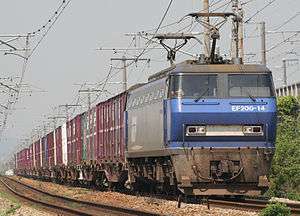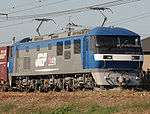JR Freight Class EF200
| Class EF200 | |||||||||||||||||||||||||||
|---|---|---|---|---|---|---|---|---|---|---|---|---|---|---|---|---|---|---|---|---|---|---|---|---|---|---|---|
 EF200-14 in revised livery in May 2009 | |||||||||||||||||||||||||||
| |||||||||||||||||||||||||||
| |||||||||||||||||||||||||||
| |||||||||||||||||||||||||||
| |||||||||||||||||||||||||||
The Class EF200 (EF200形) is a Bo-Bo-Bo wheel arrangement DC electric locomotive operated by JR Freight on freight services in Japan since 1992.[1]
Overview
The Class EF200 was developed to replace Class EF66 electric locomotives on heavy freight services on the Tokaido Main Line and Sanyo Main Line west of Tokyo.[1] It is equipped with six 1,000 kW (1,300 hp) FMT2 traction motors, giving a total power output of 6,000 kW (8,000 hp).[1] Ultimately, the class was deemed to be over-specified and unnecessarily expensive, and the order was terminated after the delivery of 20 full-production locomotives.[2] The subsequent Class EF210 was instead chosen as the standard design for hauling freight services on the Tokaido Main Line and Sanyo Main Line.[2] Originally designed to haul 1,600 tonne freight trains, problems of insufficient power supply capacity to the overhead lines, meant that the class was initially limited to hauling 1,200 tonne trains.[3]
Operations
As of 1 April 2016, the fleet consists of 12 locomotives (EF200-2 – 7, 10, 15, and 17 – 20), based at Suita Depot in Osaka.[4] They are used primarily on 1,300 t freight trains west of Tokyo on the Tokaido and Sanyo Main Lines.[3]
Variants
- EF200-900: Prototype locomotive EF200-901, built 1990
- EF200-0: Full-production locomotives EF200-1 – 20, built 1992–1993
History
The prototype locomotive, EF200-901, was delivered in March 1990 for extensive testing.[3] The first full-production locomotives were delivered to Shin-Tsurumi Depot in Tokyo in 1992, entering revenue service on the Tokaido Main Line and Sanyo Main Line from the summer of that year.[1] In 1992, the Class EF200 was awarded the Laurel Prize, presented annually by the Japan Railfan Club.[5]
From 1 April 1999, the entire class was transferred from Shin-Tsurumi in Tokyo to Suita Depot in Osaka.[3] Between 2006 and 2009, the entire fleet was repainted into a new livery similar to that used for the later Class EF210 locomotives.[6] EF200-901 was similarly repainted in 2007.[1]
From 2007, the class was power-derated to match the power output of the older Class EF66 locomotives.[2] In 2011, one class member, EF200-1, was withdrawn.[2]
During fiscal 2015, eight members of the class were removed from regular duties, leaving 12 members in service.[7]
- EF200-4 in original livery in August 1992
 Prototype locomotive EF200-901 in revised livery in August 2013
Prototype locomotive EF200-901 in revised livery in August 2013
Preserved examples
_Hitachi_Mito_Factory_20170603.jpg)
The prototype locomotive, EF200-901, was withdrawn in March 2016[8] and moved to the Hitachi Mito factory in Hitachinaka, Ibaraki, in October 2016, where it was restored to its original livery.[9]
Classification
The EF200 classification for this locomotive type is explained below. As with previous locomotive designs, the prototype was numbered EF200-901, with subsequent production locomotives numbered from EF200-1 onward.
- E: Electric locomotive
- F: Six driving axles
- 200: DC locomotive with AC motors
References
- 1 2 3 4 5 Jēāru zensharyō handobukku: Rail Magazine 2009 JR全車輌ハンドブック2009 [JR Rolling Stock Handbook 2009]. Japan: Neko Publishing. 2009. pp. 39–40. ISBN 978-4-7770-0836-0.
- 1 2 3 4 Jr機関車カタログ: Jr7社の現有30形式を詳しく解說 JR機関車カタログ [JR Locomotive Catalogue]. Japan: Ikaros Publications Ltd. 20 June 2013. pp. 40–45. ISBN 9784863207271.
- 1 2 3 4 ELダイヤ情報21 [Electric Loco Timetable Information 21]. Tokyo, Japan: Kotsu Shimbunsha. October 2012. pp. 32–33. ISBN 978-4330320120.
- ↑ Shibata, Togo (August 2016). 最新JR貨物の電気機関車と話題の貨物列車 [Latest: JR Freight electric locomotives and popular freight trains]. Tetsudo Daiya Joho Magazine (in Japanese). Vol. 45 no. 388. Japan: Kotsu Shimbun. p. 33.
- ↑ ブルーリボン賞・ローレル賞 選定車両一覧 [Blue Ribbon Award & Laurel Prize Winner List] (in Japanese). Japan: Japan Railfan Club. 25 May 2013. Archived from the original on 26 October 2010. Retrieved 15 April 2014.
- ↑ JR世代の機関車オールガイド [Comprehensive Guide to JR Era Locomotives]. Tetsudo Daiya Joho Magazine. Japan. 39 (315): 12–26. July 2010.
- ↑ JR車両ファイル2016 [JR Rolling Stock File 2016]. Japan Railfan Magazine (in Japanese). Vol. 56 no. 663. Japan: Koyusha Co., Ltd. July 2016. p. 54.
- ↑ "EF200-901". Tetsudo Hobidas (in Japanese). Japan: Neko Publishing Co., Ltd. 13 December 2016. Archived from the original on 13 December 2016. Retrieved 13 December 2016.
- ↑ EF200-901が登場時の姿で展示される [EF200-901 displayed in its original livery]. Japan Railfan Magazine Online (in Japanese). Japan: Koyusha Co., Ltd. 4 June 2017. Archived from the original on 5 June 2017. Retrieved 5 June 2017.
External links
| Wikimedia Commons has media related to JR Freight EF200. |
- JR Freight website (in Japanese)
